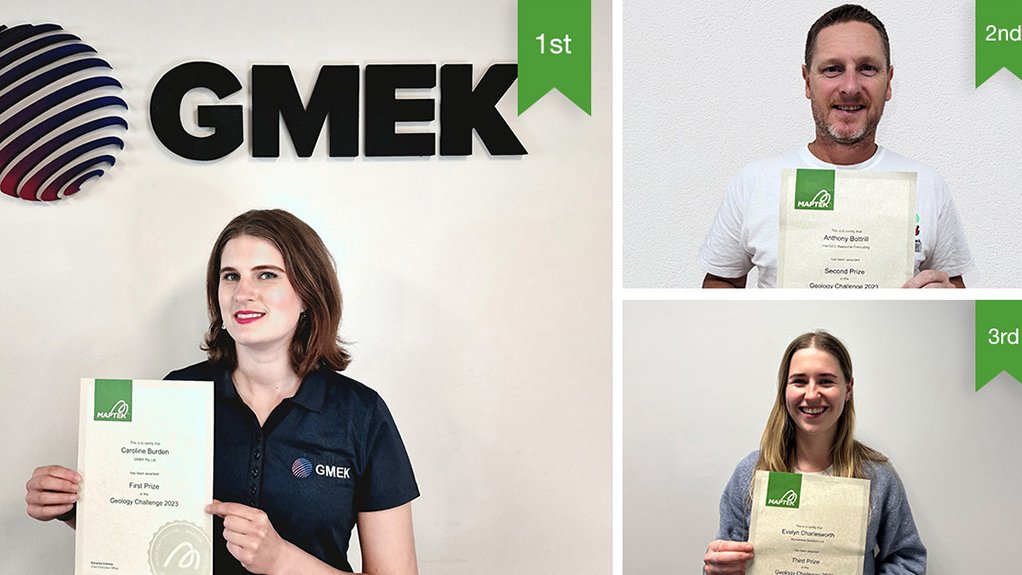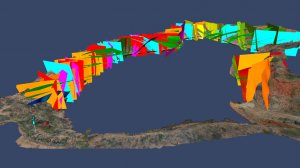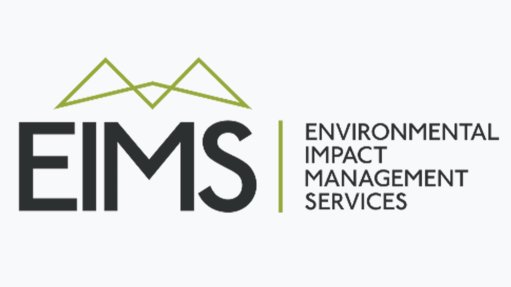Complex openpit modelling sees geologist awarded



THE WINNING TRIFECTA Three research geologists have been awarded with Maptek's Geology Challenge's top honors
GIVING IT STRUCTURE The structural mapping model created by Maptek technologies
Awarded for her work in modelling complex geological structures for an openpit operation, Australia-based ground modelling, engineering and design services company GMEK engineering geologist Caroline Burden won the Geology Challenge of mining technology developer Maptek earlier this month.
The geological dataset she was busy with comprised predominantly drillholes collected about 40 years ago for the Jubilee Metals Croydon gold project, which is located in Queensland, Australia.
Having 10-m- to 20-m-long assay intervals and inconsistent lithology records was challenging enough, but Maptek notes that, with the addition of a pit and ambitions for the Croydon project to re-enter production, after having been exposed to the elements since the 1990s, structural mapping of the project was made even more difficult for Burden.
“Previously, we processed data by manually flagging drillholes with different veins, assessed the model results and repeated, ad nauseam,” Burden says.
The early objective of completing structural mapping then snowballed into creating a geological model for her winning project submission.
Now in its third year, the Maptek Geology Challenge provides all participants access to the company’s DomainMCF, Vulcan and Vulcan GeologyCore software, for one month.
Free computing hours with Maptek machine learning engine DomainMCF was the incentive to try a more data-driven modelling approach for Burden.
DomainMCF enabled Burden to observe the three-dimensional (3D) trends of grade distribution to visualise patterns and add subsurface thrusts and faults that align with the structural mapping of the Croydon project. This helped to incorporate additional domains for fault blocks and folding to refine the veining in the models she developed.
“I could really see where those structures were possible in the subsurface. Bringing the drillholes, the acoustic televiewer data with structures picked, and the mapped data, together within Vulcan GeologyCore, helped to refine and place the structures that inherently controlled the mineralisation,” she says.
DomainMCF also helped assess structural relationships in the subsurface.
“Unsurprisingly”, Maptek notes, Burden found these structural relationships aligned with the mapped features present in the wall, highlighting the value of structural mapping and the insights revealed for geological modelling and controlling complexity.
“It is ideal for models to be largely data driven, but invariably we need a way to handle some of the statistical fuzziness to fill the gaps. Machine learning, used in conjunction with the structural data, was key in developing a more complete model, which is what we’re really hoping for,” Burden says.
Maptek awarded second place to engineering and consulting services provider InterGEO Resource Consulting principal resource geologist Anthony Bottrill, who also relished the ability to easily combine data types. This allowed him to rapidly generate a first pass 3D geochemical model using multi-element data, displaying the natural trends before conducting any interpretation.
“I was expecting to understand geological controls within the known data extents; what I did not expect was that DomainMCF would present plausible extrapolation outside the data extents,” he says.
Ultimately, Bottrill says this provided him a new understanding of the relationship between two adjacent deposits and identified a target exploration zone for the main feeder structure to the system he was assessing, at depth.
He notes that, while there are many tools for analysing multi-element data, typically this is done at the sample level (aspatial), because analysis in the 3D environment involves a lot of preparation and applied assumptions.
“DomainMCF required minimal input to set up and let the data speak for itself spatially. From there I could work on informed spatial interpretations in a way I have not been able to using other methods,” says Bottrill.
He adds that the combination of Maptek geology tools enabled him to focus on the interpretation and think about the deposit controls spatially: “This is where I believe the true value lies for a modelling geologist.
Machine learning, if used as another tool to aid our work, could offer new modelling opportunities for interpreting geology and orebodies,” says Bottrill.
Third place was awarded to water resource consultancy and research company Kōmanawa Solutions computational water resource scientist Evelyn Charlesworth for a project that sought to better understand coastal heterogeneity.
Her favourite Maptek tool was the juxtaposition viewing slider for easily comparing geological outputs of models created from different datasets.
Maptek convenor, senior geologist Richard Jackson, notes that the 2023 entries ranged across multiple commodity types and for resource geology and engineering geology applications.
“We saw some truly innovative techniques used to solve a wide range of problems,” he says.
“We set the theme of ‘controlling complexity’ and the winning submissions exceeded our expectations in using DomainMCF to both understand and control the complexity in their models,” states Jackson.
Article Enquiry
Email Article
Save Article
Feedback
To advertise email advertising@creamermedia.co.za or click here
Press Office
Announcements
What's On
Subscribe to improve your user experience...
Option 1 (equivalent of R125 a month):
Receive a weekly copy of Creamer Media's Engineering News & Mining Weekly magazine
(print copy for those in South Africa and e-magazine for those outside of South Africa)
Receive daily email newsletters
Access to full search results
Access archive of magazine back copies
Access to Projects in Progress
Access to ONE Research Report of your choice in PDF format
Option 2 (equivalent of R375 a month):
All benefits from Option 1
PLUS
Access to Creamer Media's Research Channel Africa for ALL Research Reports, in PDF format, on various industrial and mining sectors
including Electricity; Water; Energy Transition; Hydrogen; Roads, Rail and Ports; Coal; Gold; Platinum; Battery Metals; etc.
Already a subscriber?
Forgotten your password?
Receive weekly copy of Creamer Media's Engineering News & Mining Weekly magazine (print copy for those in South Africa and e-magazine for those outside of South Africa)
➕
Recieve daily email newsletters
➕
Access to full search results
➕
Access archive of magazine back copies
➕
Access to Projects in Progress
➕
Access to ONE Research Report of your choice in PDF format
RESEARCH CHANNEL AFRICA
R4500 (equivalent of R375 a month)
SUBSCRIBEAll benefits from Option 1
➕
Access to Creamer Media's Research Channel Africa for ALL Research Reports on various industrial and mining sectors, in PDF format, including on:
Electricity
➕
Water
➕
Energy Transition
➕
Hydrogen
➕
Roads, Rail and Ports
➕
Coal
➕
Gold
➕
Platinum
➕
Battery Metals
➕
etc.
Receive all benefits from Option 1 or Option 2 delivered to numerous people at your company
➕
Multiple User names and Passwords for simultaneous log-ins
➕
Intranet integration access to all in your organisation
















